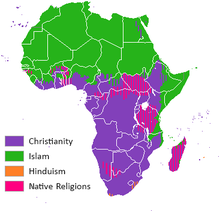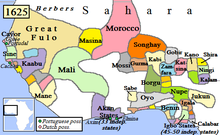
Back دخول الإسلام السودان Arabic Islamización de la región de Sudán Spanish האסלאמיזציה של סודאן HE Penyebaran Islam di Sudan ID სუდანის რეგიონის ისლამიზაცია Georgian سوڈان وچ اسلام دا داخلہ PNB Islamização da região do Sudão Portuguese
| Part of a series on |
| Islamization |
|---|
 |



The Islamization of the Sudan region (Sahel)[1] encompasses a prolonged period of religious conversion, through military conquest and trade relations, spanning the 8th to 16th centuries.
Following the 7th century Muslim conquest of Egypt and the 8th-century Muslim conquest of North Africa, Arab Muslims began leading trade expeditions into Sub-Saharan Africa, first towards Nubia, and later across the Sahara into West Africa. Much of this contact was motivated by interest in trans-Saharan trade, particularly the slave trade.
The proliferation of Islamic influence was largely a gradual process. The Christian kingdoms of Nubia were the first to experience Arab incursion starting in the 7th century. They held out through the Middle Ages until the Kingdom of Makuria and Old Dongola both collapsed in the early 14th century. Sufi orders played a significant role in the spread of Islam from the 9th to 14th centuries, and they proselytized across trade routes between North Africa and the sub-Saharan kingdom of Mali. They were also responsible for setting up zawiyas on the shores of the River Niger.
The Mali Empire underwent a period of internally motivated conversion following the 1324 pilgrimage of Musa I of Mali. Subsequently Timbuktu became one of the most important Islamic cultural centers in the Sahara. Alodia, the last holdout of Christian Nubia, was destroyed by the Funj Sultanate in 1504. During the 19th century the Sanusi order was highly involved in missionary work with their missions focused on the spread of both Islam and textual literacy as far south as Lake Chad.[2][3]
Consequently, much of the contemporary Sudan region is Muslim. This includes the Republic of Sudan (after the secession of Christian-majority South Sudan), the northern parts of Chad and Niger, most of Mali, Mauritania and Senegal. The problem of slavery in contemporary Africa remains especially pronounced in these countries, with severe divides between the Arabized population of the north and dark-skinned Africans in the south motivating much of the conflict, as these nations sustain the centuries-old pattern of hereditary servitude that arose following early Muslim conquests.[4] Ethnic strife between Arabized and non-Arab black populations has led to various internal conflicts in the Sudan region, most notably the War in Darfur, the Northern Mali conflict, and the Islamist insurgency in Northern Nigeria.
- ^ The "Sudan region" encompasses not just the history of the Republic of Sudan (whose borders are those of Anglo-Egyptian Sudan, drawn in 1899) but of the wider Sahel, in Arabic known as bilad as-sudan, "the land of the blacks".
- ^ Holt, Peter M.; Daly, Martin W. (1971). History of the Sudan: From the Coming Islam to the present day. London: Weidenfeld & Nicolson. ISBN 978-1138432192.
- ^ Duta, Paul; Ungureanu, Roxelana (November 2016). "The Sudanese civil war – the effect of arabisation and islamisation". Research and Science Today. 2 (12): 50–59. Retrieved 2020-08-05.
Islam has been introduced in Sudan by several religious orders, each with their own interpretations and dogmas, being able to talk about different sects (tariqa), the Muslim Brotherhood corresponding the schools of Muslim thinking. Each Muslim cult has its own structure, leader, space and after independence from Anglo-Egyptian condominium it has its own political party. The multitude of sects and the differences between them do not permit to speak of a Muslim community; over time, the differences between these sects have generated conflicts, fighting against each other allowing the British and Egyptians to successfully apply the adage 'divide at impera.'
- ^ "The mobilization of local ideas about racial difference has been important in generating, and intensifying, civil wars that have occurred since the end of colonial rule in all of the countries that straddle the southern edge of the Sahara Desert. [...] contemporary conflicts often hearken back to an older history in which blackness could be equated with slavery and non-blackness with predatory and uncivilized banditry." (cover text), Hall, Bruce S., A History of Race in Muslim West Africa, 1600–1960. Cambridge University Press, 2011.